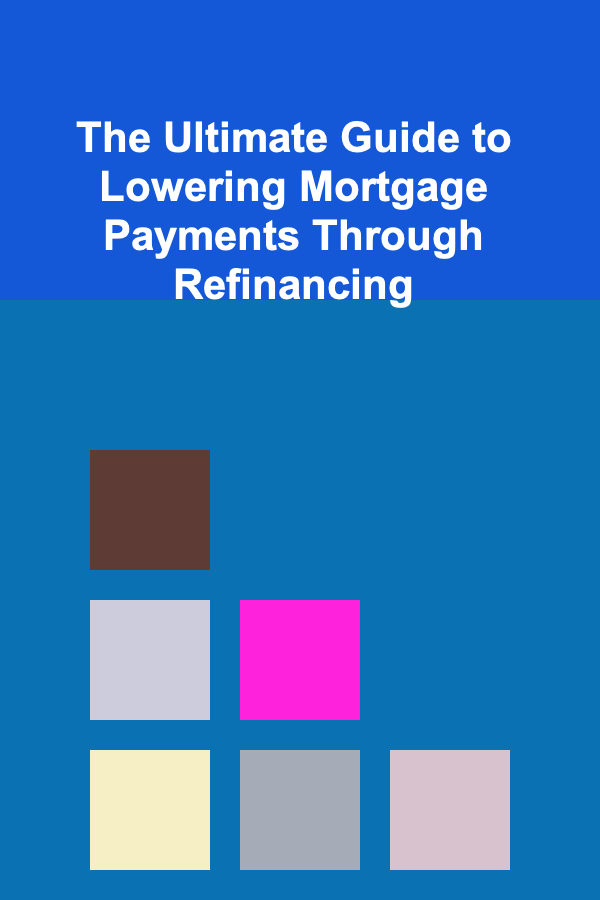
The Ultimate Guide to Lowering Mortgage Payments Through Refinancing
ebook include PDF & Audio bundle (Micro Guide)
$12.99$9.99
Limited Time Offer! Order within the next:

Owning a home is a significant milestone for many people, and for most, it involves taking out a mortgage. However, mortgage payments can sometimes become a financial strain, especially if your income fluctuates, or if interest rates rise. One strategy homeowners can use to alleviate the burden of high monthly mortgage payments is refinancing. Refinancing can help reduce your payments, secure a better interest rate, and potentially shorten your loan term.
In this guide, we will explore the process of refinancing a mortgage, the benefits and drawbacks, when to consider refinancing, and practical steps to lower your mortgage payments.
What is Mortgage Refinancing?
Mortgage refinancing is the process of replacing your current home loan with a new one, typically with better terms. Homeowners refinance their mortgages for various reasons, such as obtaining a lower interest rate, changing loan terms, consolidating debt, or even accessing the equity in their home.
There are several refinancing options available, and understanding which one is best suited to your financial goals can lead to substantial savings.
Why Refinance Your Mortgage?
There are several compelling reasons to refinance your mortgage, but the most common are:
1. Lowering Your Interest Rate
Refinancing allows you to replace your existing mortgage with a new one at a lower interest rate. This can significantly reduce your monthly payments, especially if interest rates have dropped since you originally took out your loan.
For example, if you took out a mortgage when interest rates were high but rates have since decreased, refinancing to a lower rate could save you thousands of dollars in interest over the life of the loan.
2. Reducing Monthly Payments
Refinancing can reduce your monthly mortgage payment by lowering your interest rate or extending the term of your loan. For example, if your original mortgage had a 15-year term and you refinanced to a 30-year term, your monthly payments would likely decrease, though you would pay more in total interest over the life of the loan.
3. Shortening the Loan Term
Refinancing doesn't always mean extending your loan. You can also refinance to a shorter term, such as moving from a 30-year mortgage to a 15-year mortgage. Although your monthly payments may increase slightly, you'll save a substantial amount in interest payments over the life of the loan, and you'll pay off your home much quicker.
4. Cash-Out Refinancing
If your home has appreciated in value, you may be able to tap into your home equity through a cash-out refinance. This allows you to borrow more than your current mortgage balance and receive the difference in cash. This cash could be used for home improvements, paying off high-interest debt, or funding other financial goals.
5. Consolidating Debt
If you have high-interest debt, such as credit card debt or personal loans, you may use a cash-out refinance to consolidate that debt. By rolling it into your mortgage, you can often secure a lower interest rate, making it easier to pay down debt while lowering your overall interest payments.
When Should You Refinance?
Refinancing is not right for everyone, and timing is crucial. It's important to evaluate your financial situation and the current market conditions before proceeding with refinancing. Here are some indicators that refinancing may be a good option for you:
1. Interest Rates Have Fallen
If interest rates have dropped significantly since you took out your original mortgage, refinancing can help you lock in a lower rate, which can save you money over time. A good rule of thumb is that refinancing makes sense if the interest rate on your new loan is at least 0.75% lower than your current rate. However, you may be able to benefit from refinancing with a smaller rate reduction, depending on your loan amount and remaining term.
2. Your Credit Score Has Improved
If your credit score has improved since you first took out your mortgage, you may be eligible for a lower interest rate. Refinancing can allow you to benefit from this improvement by securing more favorable loan terms.
3. You Plan to Stay in Your Home for Several More Years
Refinancing typically involves closing costs and fees, which can be substantial. If you plan to move within a few years, the upfront costs of refinancing may outweigh the savings from a lower monthly payment. As a general rule, refinancing makes the most sense if you plan to stay in your home for at least five to seven more years.
4. You Want to Change Your Loan Term
Refinancing is a good option if you want to change the length of your mortgage. For example, if you're currently paying a 30-year mortgage and want to switch to a 15-year mortgage to pay off your loan faster, refinancing is an excellent option.
5. You Want to Get Rid of Private Mortgage Insurance (PMI)
If your original mortgage required you to pay PMI because your down payment was less than 20%, refinancing may give you the opportunity to remove this cost. If your home has appreciated in value or you've paid down your mortgage enough to have more than 20% equity, you may be able to refinance and eliminate PMI payments.
The Steps to Refinancing Your Mortgage
Refinancing can be a complicated process, but breaking it down into manageable steps can help you navigate the journey successfully. Here are the essential steps to refinancing your mortgage:
1. Evaluate Your Financial Situation
Before you even start the refinancing process, it's important to assess your financial health. Consider factors such as your current credit score, outstanding debts, and the equity in your home. If your financial situation has changed, you may be in a better position to secure a more favorable loan.
2. Shop Around for the Best Rates
Once you've decided to refinance, it's crucial to compare offers from multiple lenders. Mortgage rates can vary significantly, and finding the best deal can save you thousands of dollars in interest over the life of the loan. Use online tools to compare rates and terms from different lenders, and consider consulting with a mortgage broker if you want additional guidance.
3. Check Your Credit Score
Your credit score plays a major role in the refinancing process. Lenders use your credit score to determine your interest rate and loan terms. A higher credit score generally results in a lower interest rate. Obtain a copy of your credit report to ensure your credit score is in good standing and to correct any inaccuracies that may exist.
4. Submit a Refinance Application
Once you've chosen a lender and secured a rate quote, you'll need to complete the refinance application. The application process will be similar to the one you went through when you first purchased your home. Be prepared to provide financial documentation, such as tax returns, proof of income, bank statements, and details about your current mortgage.
5. Underwriting and Appraisal
Once you've submitted your application, the lender will begin the underwriting process. This involves verifying your financial information, creditworthiness, and the value of your home. In most cases, the lender will require an appraisal to determine the current value of your property, which will help determine how much you can borrow.
6. Closing the Loan
If you're approved for refinancing, you'll need to attend a closing, just like when you originally bought your home. At the closing, you'll sign all necessary documents, pay any closing costs or fees, and finalize the loan. Once everything is complete, your old mortgage will be paid off, and you'll begin making payments on the new loan.
The Costs of Refinancing
While refinancing can save you money in the long run, it's important to be aware of the upfront costs. These can include:
- Application Fees: Fees for processing your refinance application.
- Appraisal Fees: The cost of appraising your home to determine its current value.
- Closing Costs: These can include title insurance, attorney fees, and other associated costs of closing a mortgage loan.
- Prepayment Penalties: Some loans may have penalties for paying off the mortgage early. Check with your lender before refinancing to ensure you're not subject to these fees.
Breaking Even on Refinancing
Before refinancing, make sure you understand how long it will take to recoup the costs of refinancing. This is referred to as the "break-even point." Calculate your savings from the new mortgage payments and compare them to the costs of refinancing. If the savings outweigh the costs over the time you plan to stay in your home, refinancing could be a wise decision.
Conclusion
Refinancing your mortgage can be an effective way to lower monthly payments, reduce your interest rate, or even access the equity in your home. However, it's important to assess your financial situation, shop around for the best rates, and understand the costs involved. With the right strategy, refinancing can provide significant financial relief and help you achieve your homeownership goals.
By following the steps outlined in this guide, you can navigate the refinancing process with confidence, ensuring that you make the most informed decision for your unique situation.

How to Build a Checklist for Setting Up Your Product Photography Studio
Read More
How to Explore Your Own Cultural Heritage Abroad
Read More
How to Organize Indoor Scavenger Hunts for Family Fun
Read More
How to Set Up a Checklist for Implementing Just-In-Time Restocking
Read More
How to Use Fabric Bins for Stylish Storage
Read More
How to Use Hanging Baskets for Craft Supply Storage
Read MoreOther Products

How to Build a Checklist for Setting Up Your Product Photography Studio
Read More
How to Explore Your Own Cultural Heritage Abroad
Read More
How to Organize Indoor Scavenger Hunts for Family Fun
Read More
How to Set Up a Checklist for Implementing Just-In-Time Restocking
Read More
How to Use Fabric Bins for Stylish Storage
Read More